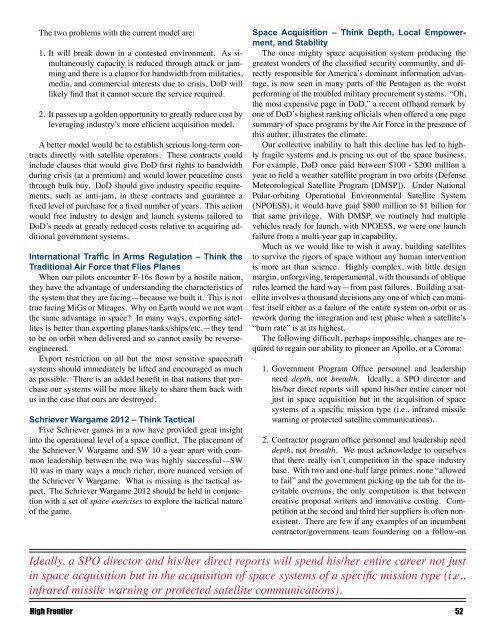Schriever Wargame 2010 - Air Force Space Command
Schriever Wargame 2010 - Air Force Space Command
Schriever Wargame 2010 - Air Force Space Command
Create successful ePaper yourself
Turn your PDF publications into a flip-book with our unique Google optimized e-Paper software.
The two problems with the current model are:<br />
1. It will break down in a contested environment. As simultaneously<br />
capacity is reduced through attack or jamming<br />
and there is a clamor for bandwidth from militaries,<br />
media, and commercial interests due to crisis, DoD will<br />
likely find that it cannot secure the service required.<br />
2. It passes up a golden opportunity to greatly reduce cost by<br />
leveraging industry’s more efficient acquisition model.<br />
A better model would be to establish serious long-term contracts<br />
directly with satellite operators. These contracts could<br />
include clauses that would give DoD first rights to bandwidth<br />
during crisis (at a premium) and would lower peacetime costs<br />
through bulk buy. DoD should give industry specific requirements,<br />
such as anti-jam, in these contracts and guarantee a<br />
fixed level of purchase for a fixed number of years. This action<br />
would free industry to design and launch systems tailored to<br />
DoD’s needs at greatly reduced costs relative to acquiring additional<br />
government systems.<br />
International Traffic in Arms Regulation – Think the<br />
Traditional <strong>Air</strong> <strong>Force</strong> that Flies Planes<br />
When our pilots encounter F-16s flown by a hostile nation,<br />
they have the advantage of understanding the characteristics of<br />
the system that they are facing—because we built it. This is not<br />
true facing MiGs or Mirages. Why on Earth would we not want<br />
the same advantage in space? In many ways, exporting satellites<br />
is better than exporting planes/tanks/ships/etc.—they tend<br />
to be on orbit when delivered and so cannot easily be reverseengineered.<br />
Export restriction on all but the most sensitive spacecraft<br />
systems should immediately be lifted and encouraged as much<br />
as possible. There is an added benefit in that nations that purchase<br />
our systems will be more likely to share them back with<br />
us in the case that ours are destroyed.<br />
<strong>Schriever</strong> <strong>Wargame</strong> 2012 – Think Tactical<br />
Five <strong>Schriever</strong> games in a row have provided great insight<br />
into the operational level of a space conflict. The placement of<br />
the <strong>Schriever</strong> V <strong>Wargame</strong> and SW 10 a year apart with common<br />
leadership between the two was highly successful—SW<br />
10 was in many ways a much richer, more nuanced version of<br />
the <strong>Schriever</strong> V <strong>Wargame</strong>. What is missing is the tactical aspect.<br />
The <strong>Schriever</strong> <strong>Wargame</strong> 2012 should be held in conjunction<br />
with a set of space exercises to explore the tactical nature<br />
of the game.<br />
<strong>Space</strong> Acquisition – Think Depth, Local Empowerment,<br />
and Stability<br />
The once mighty space acquisition system producing the<br />
greatest wonders of the classified security community, and directly<br />
responsible for America’s dominant information advantage,<br />
is now seen in many parts of the Pentagon as the worst<br />
performing of the troubled military procurement systems. “Oh,<br />
the most expensive page in DoD,” a recent offhand remark by<br />
one of DoD’s highest ranking officials when offered a one page<br />
summary of space programs by the <strong>Air</strong> <strong>Force</strong> in the presence of<br />
this author, illustrates the climate.<br />
Our collective inability to halt this decline has led to highly<br />
fragile systems and is pricing us out of the space business.<br />
For example, DoD once paid between $100 - $200 million a<br />
year to field a weather satellite program in two orbits (Defense<br />
Meteorological Satellite Program [DMSP]). Under National<br />
Polar-orbiting Operational Environmental Satellite System<br />
(NPOESS), it would have paid $800 million to $1 billion for<br />
that same privilege. With DMSP, we routinely had multiple<br />
vehicles ready for launch, with NPOESS, we were one launch<br />
failure from a multi-year gap in capability.<br />
Much as we would like to wish it away, building satellites<br />
to survive the rigors of space without any human intervention<br />
is more art than science. Highly complex, with little design<br />
margin, unforgiving, temperamental, with thousands of oblique<br />
rules learned the hard way—from past failures. Building a satellite<br />
involves a thousand decisions any one of which can manifest<br />
itself either as a failure of the entire system on-orbit or as<br />
rework during the integration and test phase when a satellite’s<br />
“burn rate” is at its highest.<br />
The following difficult, perhaps impossible, changes are required<br />
to regain our ability to pioneer an Apollo, or a Corona:<br />
1. Government Program Office personnel and leadership<br />
need depth, not breadth. Ideally, a SPO director and<br />
his/her direct reports will spend his/her entire career not<br />
just in space acquisition but in the acquisition of space<br />
systems of a specific mission type (i.e., infrared missile<br />
warning or protected satellite communications).<br />
2. Contractor program office personnel and leadership need<br />
depth, not breadth. We must acknowledge to ourselves<br />
that there really isn’t competition in the space industry<br />
base. With two and one-half large primes, none “allowed<br />
to fail” and the government picking up the tab for the inevitable<br />
overruns, the only competition is that between<br />
creative proposal writers and innovative costing. Competition<br />
at the second and third tier suppliers is often nonexistent.<br />
There are few if any examples of an incumbent<br />
contractor/government team foundering on a follow-on<br />
Ideally, a SPO director and his/her direct reports will spend his/her entire career not just<br />
in space acquisition but in the acquisition of space systems of a specific mission type (i.e.,<br />
infrared missile warning or protected satellite communications).<br />
High Frontier 52

















